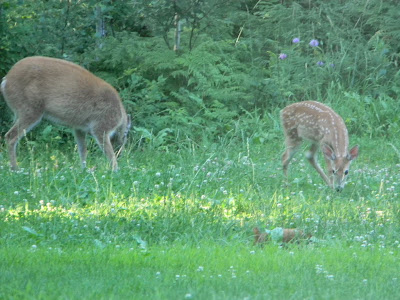It has been a busy weekend. I harvested my vertically challenged carrots. Made salsa and Jody's recipe rocks! Made more raspberry jam. Canned some cherry tomatoes. To wrap it all up I am making a roast with my baby carrots and the potatoes that I manage to nick each one when I was digging them up. I am still picking raspberries and now the chokecherries are starting. I went down to our pond and harvested the sweetgrass. I managed to get 3 braids. The house would smell beautiful, except the onions and garlic are permeating the premises.
You can't tell the carrots from the cherry tomatoes. The onions didn't grow for some reason either. They are in the leaf shaped dish at the bottom left. Raspberries are in the upper right bowl and chokecherries in the lower middle. My potato harvest wasn't earth shattering, but enough for one roast. I know it doesn't look like a tremendous amount, but just knowing I grew it and am using it is worth while.
I have some new friends in my greenhouse. A little snake has denned up. He is extremely shy and it took me forever to get this photo. I don't mind snakes at all, so I'm happy to share the greenhouse with him.

I'm not as happy to share the greenhouse with this old matriarch. She set up camp last week and I have had to be very cautious as to her whereabouts. For some reason I have never been able to kill spiders. I am going to Washington DC this week and my husband who detests both spiders and snakes has to water my greenhouse every morning. I relocated the old girl today. I'm afraid he is stuck with the snake.
I'm going to leave you with this pickled cherry tomato recipe that I got from The Country Store by Stephanie Donaldson. It is one of my favorite books. I tried the recipe last night and I really like it.
Pickled Cherry Tomatoes
2 1/4 lb cherry tomatoes
1 t. salt per 4 cup jar
1 t. sugar per 4 cup jar
fresh basil or parsley
5 garlic cloves per jar
1. Prick each tomato with a toothpick.
2. Pack the tomatoes into a clean dry jar, adding the salt and sugar as you go.
3. Pack the jars with tomatoes to within 3/4 inches from the top. Tuck the basil or parsley and garlic among the tomatoes.
4. Rest the lids on the jars, but do not seal.
5. Stand the jars in the oven at 250 degrees for 45 minutes. The juice should be simmering.
6. Remove the jars from the oven and seal. Store in a cool place and use within 6 months.


















































